OCZ Vector 150 (120GB & 240GB) Review
by Kristian Vättö on November 7, 2013 9:00 AM EST- Posted in
- Storage
- SSDs
- OCZ
- Indilinx
- Vector 150
Performance Consistency
In our Intel SSD DC S3700 review Anand introduced a new method of characterizing performance: looking at the latency of individual operations over time. The S3700 promised a level of performance consistency that was unmatched in the industry, and as a result needed some additional testing to show that. The reason we don't have consistent IO latency with SSDs is because inevitably all controllers have to do some amount of defragmentation or garbage collection in order to continue operating at high speeds. When and how an SSD decides to run its defrag and cleanup routines directly impacts the user experience. Frequent (borderline aggressive) cleanup generally results in more stable performance, while delaying that can result in higher peak performance at the expense of much lower worst-case performance. The graphs below tell us a lot about the architecture of these SSDs and how they handle internal defragmentation.
To generate the data below we take a freshly secure erased SSD and fill it with sequential data. This ensures that all user accessible LBAs have data associated with them. Next we kick off a 4KB random write workload across all LBAs at a queue depth of 32 using incompressible data. We run the test for just over half an hour, nowhere near what we run our steady state tests for but enough to give a good look at drive behavior once all spare area fills up.
We record instantaneous IOPS every second for the duration of the test and then plot IOPS vs. time and generate the scatter plots below. Each set of graphs features the same scale. The first two sets use a log scale for easy comparison, while the last set of graphs uses a linear scale that tops out at 40K IOPS for better visualization of differences between drives.
The high level testing methodology remains unchanged from our S3700 review. Unlike in previous reviews however, we vary the percentage of the drive that gets filled/tested depending on the amount of spare area we're trying to simulate. The buttons are labeled with the advertised user capacity had the SSD vendor decided to use that specific amount of spare area. If you want to replicate this on your own all you need to do is create a partition smaller than the total capacity of the drive and leave the remaining space unused to simulate a larger amount of spare area. The partitioning step isn't absolutely necessary in every case but it's an easy way to make sure you never exceed your allocated spare area. It's a good idea to do this from the start (e.g. secure erase, partition, then install Windows), but if you are working backwards you can always create the spare area partition, format it to TRIM it, then delete the partition. Finally, this method of creating spare area works on the drives we've tested here but not all controllers are guaranteed to behave the same way.
The first set of graphs shows the performance data over the entire 2000 second test period. In these charts you'll notice an early period of very high performance followed by a sharp dropoff. What you're seeing in that case is the drive allocating new blocks from its spare area, then eventually using up all free blocks and having to perform a read-modify-write for all subsequent writes (write amplification goes up, performance goes down).
The second set of graphs zooms in to the beginning of steady state operation for the drive (t=1400s). The third set also looks at the beginning of steady state operation but on a linear performance scale. Click the buttons below each graph to switch source data.
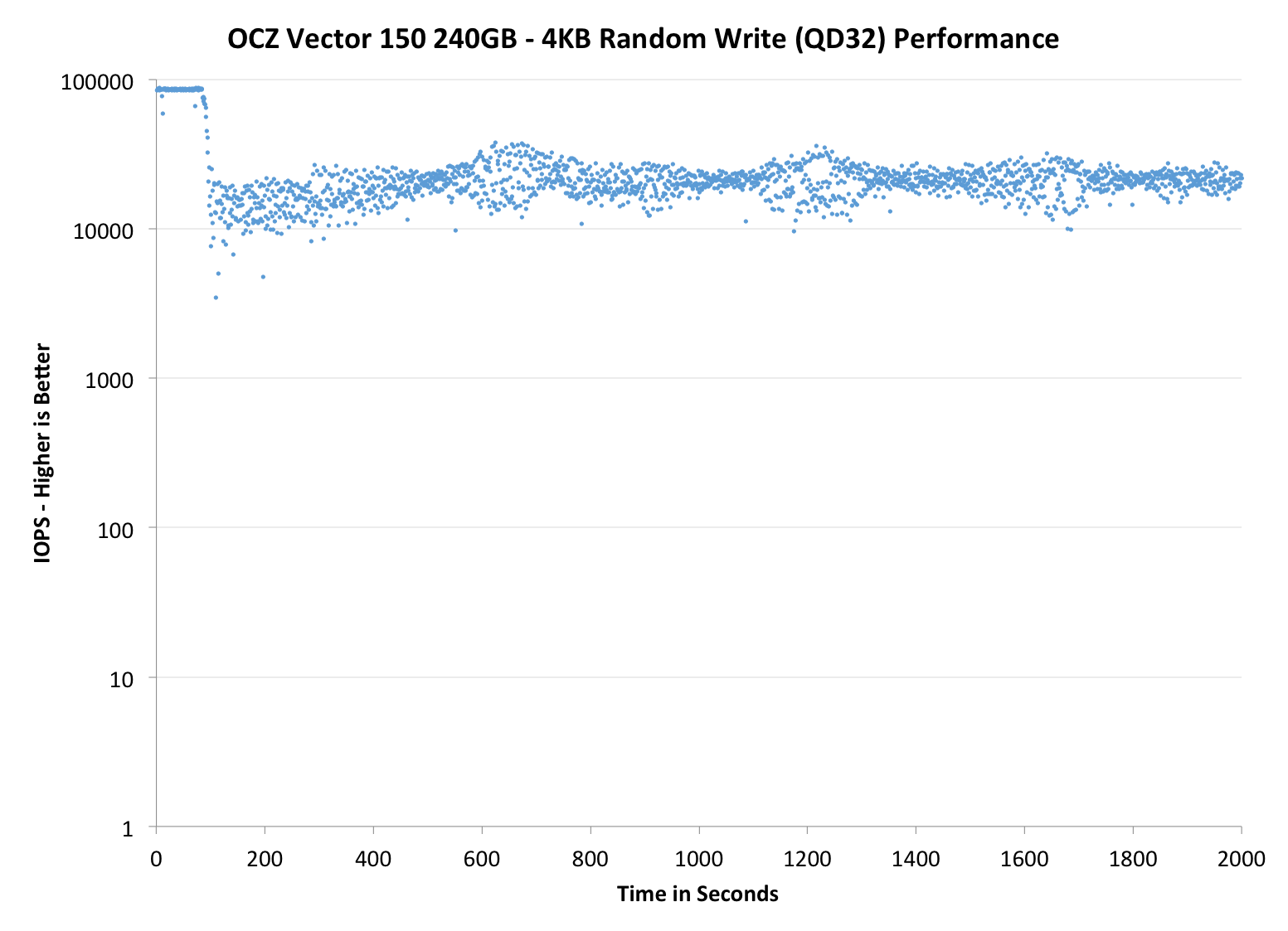 |
|||||||||
| OCZ Vector 150 240GB | OCZ Vector 256GB | Corsair Neutron 240GB | Sandisk Extreme II 480GB | Samsung SSD 840 Pro 256GB | |||||
| Default | |||||||||
| 25% OP | |||||||||
Performance consistency is simply outstanding. OCZ told us that they focused heavily on IO consistency in the Vector 150 and the results speak for themselves. Obviously the added over-provisioning helps but if you compare it to the Corsair Neutron with the same ~12% over-provisioning, the Vector 150 wins. The Neutron and other LAMD based SSDs have been one of the most consistent SSDs to date, so the Vector 150 beating the Neutron is certainly an honorable milestone for OCZ. However if you increase the over-provisioning to 25%, the Vector 150's advantage doesn't scale. In fact, the original Vector is slightly more consistent with 25% over-provisioning than the Vector 150 but both are definitely among the most consistent.
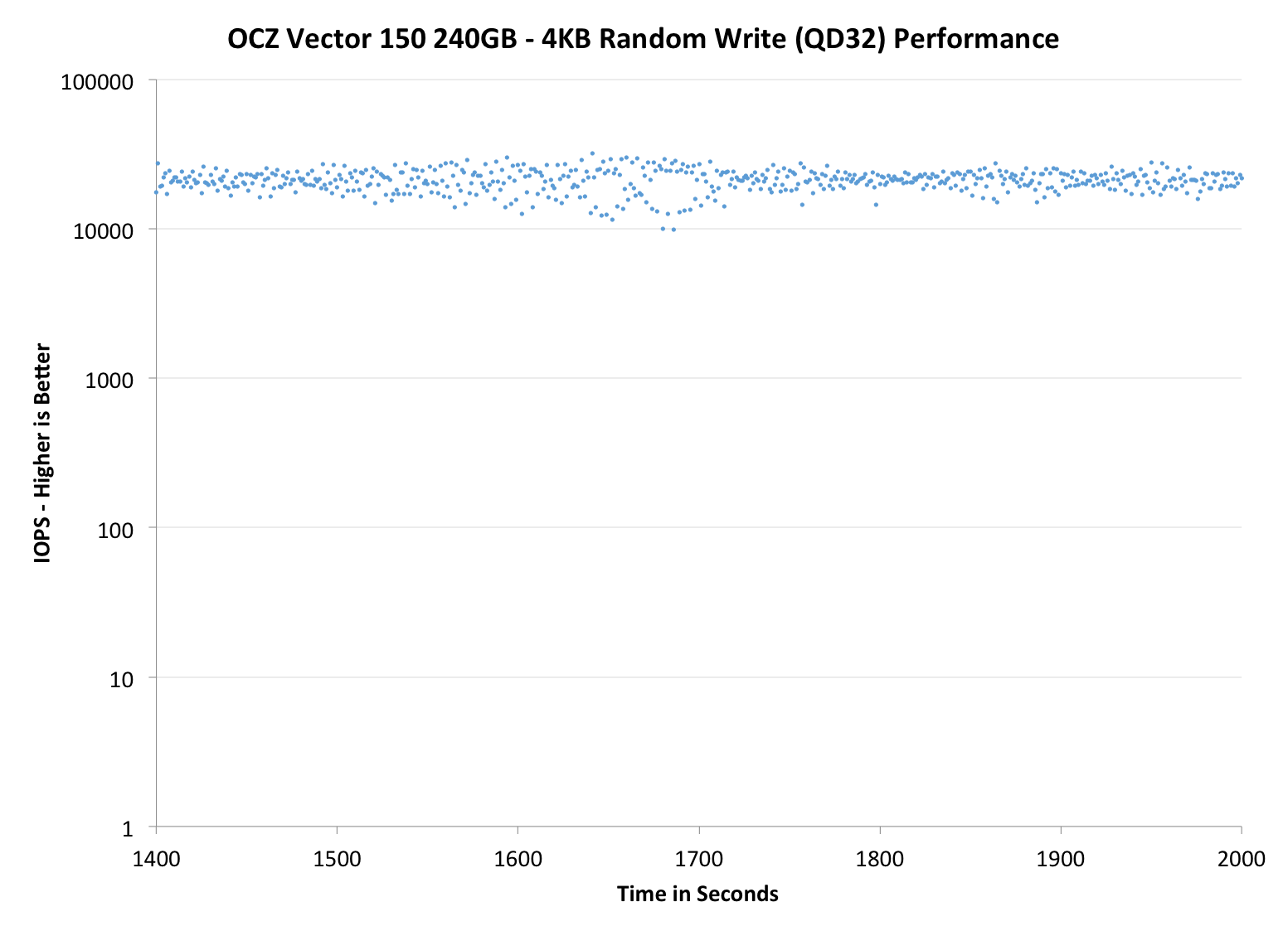 |
|||||||||
| OCZ Vector 150 240GB | OCZ Vector 256GB | Corsair Neutron 240GB | SanDisk Extreme II 480GB | Samsung SSD 840 Pro 256GB | |||||
| Default | |||||||||
| 25% OP | |||||||||
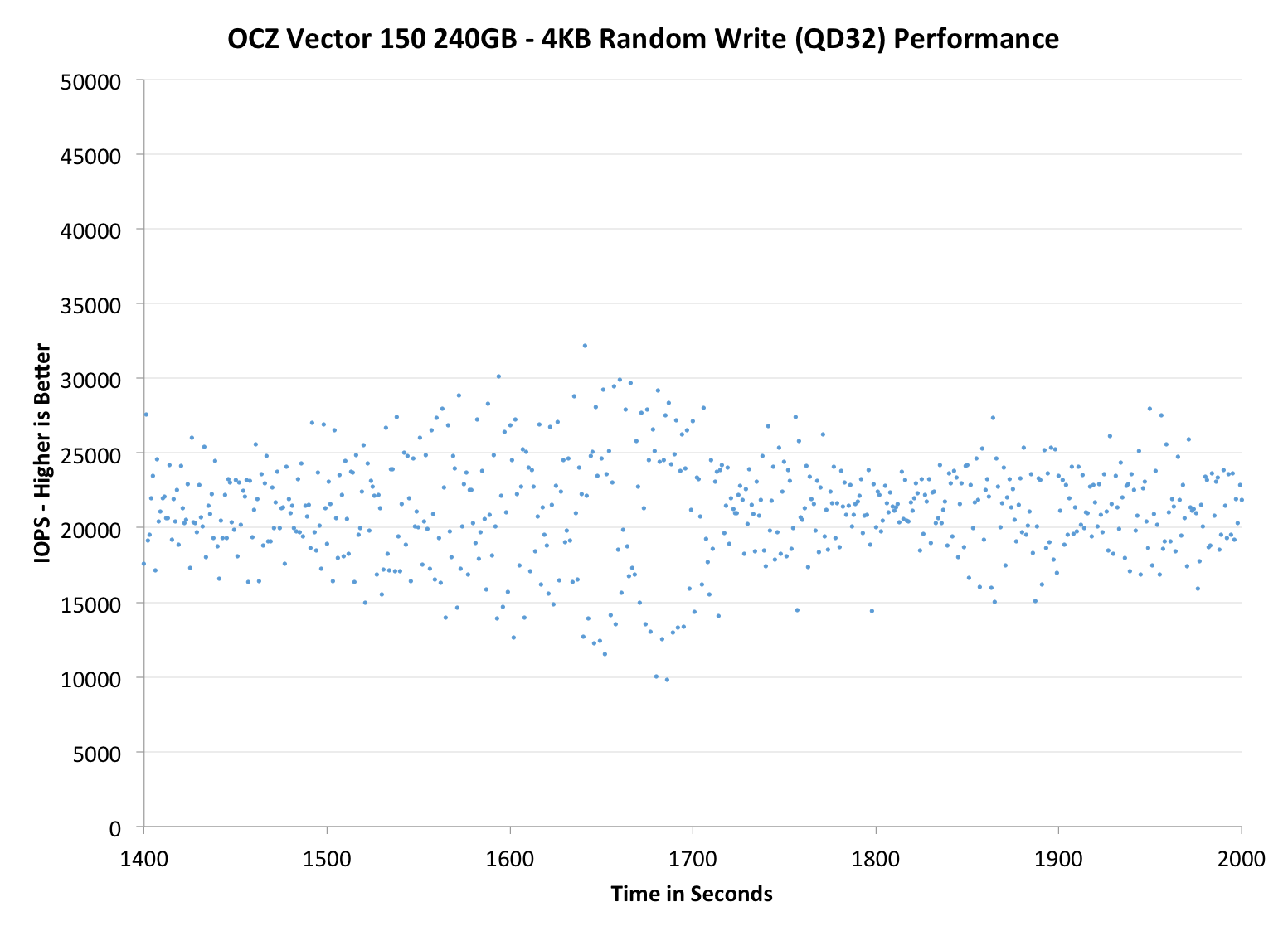 |
|||||||||
| OCZ Vector 150 240GB | OCZ Vector 256GB | Corsair Neutron 240GB | SanDisk Extreme II 480GB | Samsung SSD 840 Pro 256GB | |||||
| Default | |||||||||
| 25% OP | |||||||||
TRIM Validation
Above is an HD Tach graph I ran on a secure erased drive to get the baseline performance. The graph below is from a run that I ran after our performance consistency test (first filled with sequential data and then hammered with 4KB random writes at queue depth of 32 for 2000 seconds):
And as always, performance degrades, although the Vector 150 does pretty good with recovering the performance if you write sequential data to the drive. Finally I TRIM'ed the entire volume and reran HD Tach to make sure TRIM is functional.
It is. You can also see the impact of OCZ's "performance mode" in the graphs. Once 50% of the LBAs have been filled, the drive will reorganize the data, which causes the performance degradation. If you leave the drive idling after filling over half of it, the performance will return close to brand new state within minutes. Our internal tests with the original Vector have shown that the data reorganization takes less than 10 minutes, so it's nothing to be concerned about. The HD Tach graphs give a much worse picture of the situation than it really is.



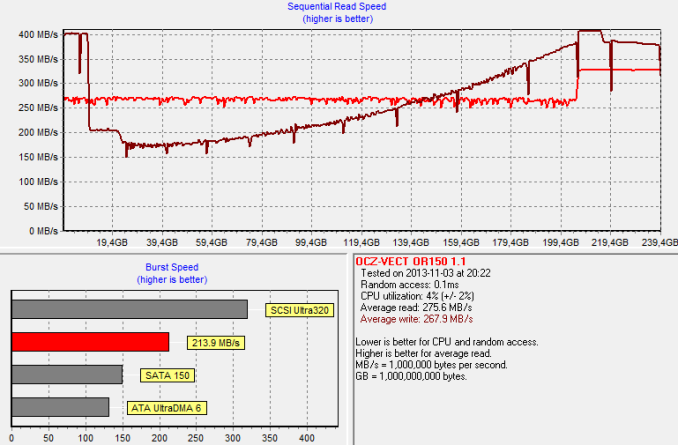
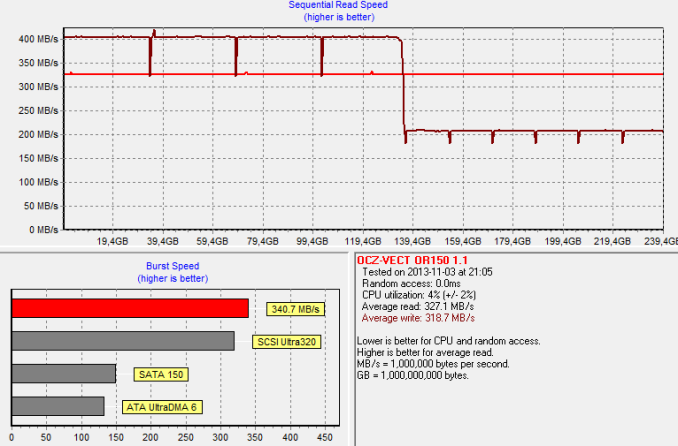








59 Comments
View All Comments
Kristian Vättö - Friday, November 8, 2013 - link
Actually, I've already tested the Intel SSD 530 and am just waiting for Intel to confirm a few things so I can push the review live. I didn't want to include the results here as it kind of ruins the idea of a review if all the scores have been published beforehand. But you should expect the review to surface early next week :)HisDivineOrder - Thursday, November 7, 2013 - link
OCZ's been taking a beating in profits. If you look at the sheer number of refurb deals on OCZ drives as of late, it looks like they're dumping their inventory at reduced prices with virtually no warranties, hoping to clear out warehouses. They're trying to make a quick buck in a hurry because their stock is taking a beating after their profits didn't line up.I'd say this might be one of the last times you read an OCZ SSD review.
Bob Todd - Thursday, November 7, 2013 - link
My only truly horrid SSD experience has been with an Agility 4. Data corruption, randomly not even appearing in the BIOS (on common Intel SATA controllers), etc. RMA'd it once. The replacement did the same thing. RMA'd that one too. The third one is just as bad, and it's sitting in a desk drawer until I get around to sending it back yet again. That's with the latest firmware. Completely anecdotal of course, but 3 bad drives in a row from OCZ when I've never had similar issues with a larger set of drives from Crucial, Plextor, and Kingston.Souka - Thursday, November 7, 2013 - link
Reminds me of the Hitachi Deathstar...er Deskstar drive series... click click clck...gus6464 - Thursday, November 7, 2013 - link
Who in their right mind would buy an OCZ drive over a Samsung, Intel, Crucial, Sandisk, Plextor?wonderblue - Thursday, November 7, 2013 - link
I must be the only person on the planet who bought an OCZ SSD and didn't have it fail.128GB vertex 3 going strong for a year so far.
killerroach - Thursday, November 7, 2013 - link
I still boot my desktop off of a 60GB Vertex. Not a Vertex 3, Vertex 2... original Vertex. Still going strong.evonitzer - Friday, November 8, 2013 - link
Yeah, I feel like I'm the luckiest guy around with my OCZ. Or else (gasp!) these comments exaggerate the situation a wee bit.kmmatney - Friday, November 8, 2013 - link
I still have a 60GB Agility 2 running fine, although I've been using it as a giant external USB memory stick for the last year (using a USB to SATA adapter that came with a Samsung SSD). It's work amazing as a memory stick, copying files at about 30mb/sec on USB 2.Gigaplex - Friday, November 8, 2013 - link
My Agility 3 is still going too *fingers crossed*